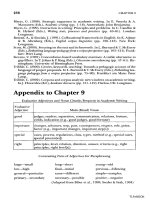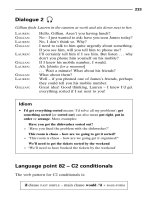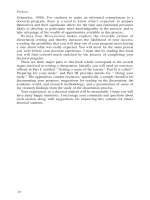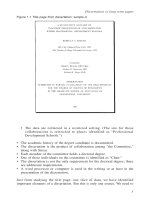Writing your doctoral dissertation - part 26 docx
Bạn đang xem bản rút gọn của tài liệu. Xem và tải ngay bản đầy đủ của tài liệu tại đây (91.52 KB, 5 trang )
Analyzing and interpreting your data
125
interpretation are two sides of one coin, or reciprocal processes, each leading
to the other.
It is your responsibility, from your in-depth familiarity with your data, to
represent your data honestly and appropriately. The more support you can
provide, the more likely your readers will be to concur with your analysis.
Figure 12.1 graphically represents a cyclical process integral to the writing
of your dissertation. Ultimately, there is a point at which you say, “Enough! I
know what I’ve found.” That’s when you’re ready to write the final draft of
your findings.
Figure 12.1 A schematic representation of the typical recursive process in writing
a dissertation
126
13 Presenting Your Findings
Drafting and Editing
Your Dissertation
Towards the completion of it all, it seemed that a new world had opened up to
me. I found that exhilarating.
The accomplishment of completing a rigorous academic effort is quite uplifting.
You are now ready to write up your findings in a polished state for public
scrutiny. And “scrutiny” is the operative term. Expect that each of your
“findings” will be subjected to intensive study. You will initially draft some
organizational strategies projecting the potential contents of sections of your
chapters. You will place in these sections all the relevant materials you have
collected and analyzed. At first this will probably involve creating numerous
files with scraps of papers, notes, transcripts, test scores, etc. Eventually, you
will distill this amalgam of papers, identifying the most important issues and
highlighting these in your presentation. You will constantly revise these as
you proceed in presenting your findings. In actuality, you are probably
discovering what you found concurrent with writing this section. Once a first
draft is completed, you will be in a better position to revise your text, helping
your readers to understand what you now know you have discovered.
Your chair may work with you in this process, or, more typically, will
respond to drafts you provide. As you progress, you will get a better sense of
where information should be presented to facilitate your readers’
understanding of both the process and the outcomes of your study.
As agreed with your chair and your committee, you will offer drafts for their
review. When you discuss their reactions and suggestions to your drafts, you
should obtain clarity on confusing issues as well. There is usually a healthy
intellectual dialog which occurs in this process during which time your analysis
becomes enhanced, and your committee becomes informed of your progress
directing and guiding your thinking. During these conversations, your
committee may ask questions about your draft, to which you should be ready
to respond. Look on these interactions as opportunities to explain what you
have done, without being either defensive or docile. You should be able to
explain your rationale, based on others who preceded you, or based on your
understanding of the specific situation in which you found yourself. Regardless
of the basis, be prepared to respond. If you believe your reader has
misunderstood your meaning, be prepared to clarify your intent expansively
Presenting your findings
127
and then revise your written text so that it is clearer for all subsequent readers.
After you have taken a great deal of time thinking about issues, be prepared to
defend your thinking while listening to alternative perspectives.
As the researcher, it is your responsibility to explain in great detail what
you found: what you discovered from your data; what new insights you have
about such phenomena as, for example, the way that people write essays in
class or the way that books are organized. You serve as a guide to your
readers, preventing them from getting lost looking at isolated trees, and
helping them to see the forest the way that you now understand it, based on
your intensive, careful analysis.
You will need to discover what you “found” before you can create the final
textual presentation of this section. Most students find it useful to write many
notes and drafts of this aspect of the research prior to polishing a chapter
which reports on the findings. Consequently, students frequently create tables
and figures, then explain what these syntheses of their data mean in narrative
form, and, finally, organize these sections into a cohesive and powerful
chapter of their dissertation which explains the findings.
Your data are the evidence supporting your findings. Based on your
systematic and intensive interrogation of these data, you will infer potential
explanations for them. Your inferences are data driven, based on your
interpretation of what your data reveal. You may make some inferences which
are not supported by your data. These you will need to discard. You want to
identify inferences which both are supported by your data and offer a
comprehensive understanding of your data.
As you obtain confidence in the fit between your data and the inference(s),
you will explicitly state the inference(s) or general principle(s) which explain
your findings. You may also want to identify any qualifications or limitations
on those general principles, such as age, sex, or context.
This expansive presentation of your thinking will enable readers to follow
your interpretation and ultimately accept your perspective when your
explanation is reasonable to them. It will also enable you to review your
thinking consciously, and perhaps find weaknesses or omissions which need
to be remedied. If your interpretation is thorough, clear, logical, relevant, and
cautious, it is likely to be compelling to your readers. And it will provide the
opportunity for an informed discussion, along with an important contribution
to your academic discipline.
Creating a Compelling Argument for your Findings
It is possible that your findings may contradict current thinking. If your
findings “surprised” you in some way, and this is one important phenomenon
inherent in the research process, then your findings are likely to surprise
others. It is your responsibility to convince your readers at least to consider
the accuracy of your analysis by providing sufficient information for them to
make independent judgments. This may take the form of quotations from
Presenting your findings
128
interviews, or test scores, for example. These samples of your data, in
combination with your narrative explanation of the inferences you are
making, will position your readers to consider your interpretation along with
their own, weighing any differences, and particularly focusing on the
elements which you emphasize in your presentation. There are several criteria
which are useful in drafting a compelling argument:
a thorough interpretation;
a clear interpretation;
a logical interpretation;
a relevant interpretation;
a cautious interpretation.
A Thorough Interpretation
A thorough interpretation of your data synthesizes the individual units of
analysis (e.g. words, sentences, responses, test scores, weight, etc.) into a
more comprehensive context. For an interpretation to be considered
“thorough,” it needs to account for all the major dimensions which you
studied, as identified in your research question. You will lead your readers to
focus on the larger issues, a perspective which you have from your intimate
familiarity with your data. Your ability to create a cohesive whole from the
isolated bits and pieces of your data will be one factor in creating a thorough
interpretation. Your explanations of the potential meanings to be drawn from
data presented in spread sheets, figures, photos, excerpts from transcripts,
etc., should be multidimensional, suggesting multiple potential perspectives
on your data. As you guide your readers, you create a compelling argument
for interpreting your data in a specific way. On the other hand, you may offer
competing interpretations for your data. The choice you make is based on
your data. If your data are clear cut, there is no controversy. In some cases,
the data are not that clear cut, requiring an honest researcher to offer
competing interpretations.
Your readers should have a sense that your interpretations represent an
exhaustive search for meaning from your data. They should also get a sense
that you have included all the essential information, and that you have not
arbitrarily excluded information relevant to the analysis. Your honesty as a
researcher is attested to by your comprehensive inclusion of all your data,
even data which may challenge your inferences.
Presenting your findings
129
A Clear Interpretation
A clear interpretation is easy to follow. Information is presented systematically
and predictably. Symbols in graphs and within the text are explained. Details
are provided to enable an intelligent reader to understand the issues. There is
meticulous attention to getting the facts correct. The information presented in a
table should be consistent with the information presented in the narrative. When
there are discrepancies, the reader is at a loss to know which is accurate, and
therefore may become disillusioned with the quality of the research being
reported. When transcripts are quoted, line references should be exact, directing
your reader’s attention to the precise words on which you are commenting. If a
reader has difficulty following your argument, you jeopardize the possibility
that your study will be misinterpreted or rejected. Your careful choice of words
will reflect your clear understanding of your findings.
The organization of your information in a concise, flowing text evolves
from a comprehensive and cohesive understanding of your findings, knowing
which parts are subsumed under the key findings.
A Logical Interpretation
Your reader will consider your interpretation “logical” if you organize your
presentation in a systematic and predictable fashion. From your understanding
of your data, you decide which issue needs to be addressed first, and which
follows naturally from that first issue. You will also provide a sketch of the
order in which you will discuss your findings, enabling your readers to create
a mental map of your presentation, and then to find that information as they
peruse your text. Your presentation should lead your readers to understand your
findings as clearly as you do. Usually, simultaneously with your writing of this
section, your understanding becomes crystallized.
A Relevant Interpretation
Your findings must be directly related to three components of your study:
• your research question and the theories and/or sources which contributed
to its identification;
• the data which you collected; and
• your data analysis.
Information from other sources is irrelevant at this point. Your interpretation
must be focused on important issues. Whereas there may be many details
included in the data which you collected, and your analysis may have focused
on a multitude of elements, you now need to decide the most important
issues. You want to highlight the most prominent, and the strongest findings









